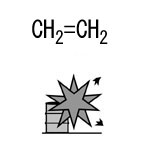| Case Name |
Explosion and fire caused due to gas leakage from high-pressure ethylene piping at an ethanol manufacturing plant |
| Pictograph |

|
| Date |
May 2, 1997 |
| Place |
Yokkaichi, Mie, Japan |
| Location |
Chemical factory |
| Overview |
During usual operation of an ethanol plant, an explosion occurred in recycle gas piping near the reactor. The tee joint of high-pressure piping for recycle gas (mainly ethylene) became thin due to erosion corrosion. It could no longer withstand the internal pressure, and ethylene leaked. An explosion and a fire occurred. As a vapor liquid mixed flow containing water was flowing at a high speed, corrosion progressed remarkably. |
| Incident |
An explosion occurred during usual operation of a reaction process at an ethanol plant. A T-type joint of high-pressure piping for recycling gas (mainly ethylene) was damaged, ethylene leaked, was ignited by static electricity, and an explosion and a fire occurred. |
| Processing |
Manufacture |
| Individual Process |
Reaction |
| Process Flow |
Fig2.Unit process flow
|
| Chemical Reaction |
Addition |
| Chemical Equation |
Fig3.Chemical reaction formula
|
| Substance |
Ethylene, Fig4 |
| Type of Accident |
Leakage, Explosion, fire |
| Sequence |
An ethanol plant was operated as usual.
17:03 on May 2nd, 1997. An abnormal sound and smoke were detected during patrol of the plant.
17:04. A fire occurred after an explosion.
17:05. An emergency shutdown of the plant was executed.
17:06. The public Fire department was notified. 14 fire engines and 100 fire fighters turned out.
17:09. Initial fire extinguishing was performed by a self-defense fire team using an outdoor fire hydrant, and the fire was almost extinguished.
17:19. The fire was confirmed to have been extinguished.
20:30. As the ethylene concentration at the reactor outlet had reached almost zero, water spraying was stopped. |
| Cause |
The plant was operated at a high load for about ten years. The end portion of the tee joint of piping became thin due to erosion corrosion caused by a high-speed (in the past 14.5 m/s, at the time of an accident 12.2 m/s) vapor liquid mixed flow (93% of gas) of high-temperature and high-pressure ethylene and water. It could no longer withstand the internal pressure and ruptured. |
| Response |
An emergency shut down of the plant.
An emergency relief valve was opened and pressure was lowered.
Fire fighting work using an outdoor fire hydrant. |
| Countermeasures |
Review of maintenance management of piping.
Annual inspection of fixed points and intensive measurement every five years.
Material of piping was changed to chromium molybdenum steel from carbon steel.
Equipment diagnosis by an external specialized agency for aged facilities.
Strengthening of flow velocity management in piping. |
| Knowledge Comment |
It is clear that corrosion is promoted by the presence of water. Furthermore, if there is a local vortex accompanying a high-speed flow, a decrease in thickness will be promoted by erosion corrosion.
On increasing the treating amount without changing equipment, even if there is no influence for a short period, it may become a big problem over a long period.
This accident is involved with such a problem and a wide range of study is required. |
| Background |
It is considered to be a typical example of inadequate facilities management. Pure water was injected into recycling ethylene and the injected water evaporated. Then, ethylene and water generated ethanol on a solid catalyst in this process. Leakage occurred at the outlet of a heat exchanger after water injection, and the state of a vapor liquid mixed flow changed according to operating conditions. According to the report, there was a mixed flow of 7% liquid, and 93% gas. It is not known whether this value is a design condition or an actual operating condition. In the original design, it seems that erosion corrosion caused by the vapor liquid mixed flow is not assumed. It is based on the assumption that a moderate condition in which a suitable flow speed and the liquid proportion are kept. The production rate increased, and the capacity of the heat exchanger decreased relatively, injected water could not evaporate in the same ratio, and the proportion of liquid increased. These factors promoted the erosion corrosion rate. Insufficient study at the time of the throughput increase and lack of subsequent follow-up are considered to be the causes.
It was an introduced technology, and there might have been insufficient understanding of technical aspects. However, a quantitative evaluation is fairly difficult although it is very simple ualitatively. |
| Reason for Adding to DB |
Example of explosion caused due to erosion of piping from a high-velocity mixed flow |
| Scenario |
| Primary Scenario
|
Poor Value Perception, Poor Safety Awareness, Inadequate Risk Recognition, Organizational Problems, Poor Management, Poor Equipment Management, Usage, Maintenance/Repair, Inspection, Planning and Design, Poor Planning, Excess Operation Planning, Bad Event, Thermo-Fluid Event, Mixed Flow, Failure, Abrasion, Errosion, Secondary Damage, External Damage, Leakage/Explosion
|
|
| Sources |
Fire and Disaster Management Agency, Ethylene gas explosion and fire caused by leakage from high pressure piping in ethanol plant, Accident cases of dangerous materials, 1997, pp.76-77.
National dangerous object safe association, Fire at manufacturer: 100 cases of accidents in dangerous facilities - p.10, (1999).
|
| Physical Damage |
Damage caused due to a fire of a heating furnace. A rupture of piping and damage of thermal insulation. Damage caused by a fire of a hydration reactor and piping from a heating furnace to a reactor. |
| Financial Cost |
¥ 1 million (Fire and Disaster Management Agency). |
| Multimedia Files |
Fig4.Chemical formula
|
| Field |
Chemicals and Plants
|
| Author |
ITAGAKI, Haruhiko (Japan National Institute of Occupational Safety and Health)
TAMURA, Masamitsu (Center for Risk Management and Safety Sciences, Yokohama National University)
|
|